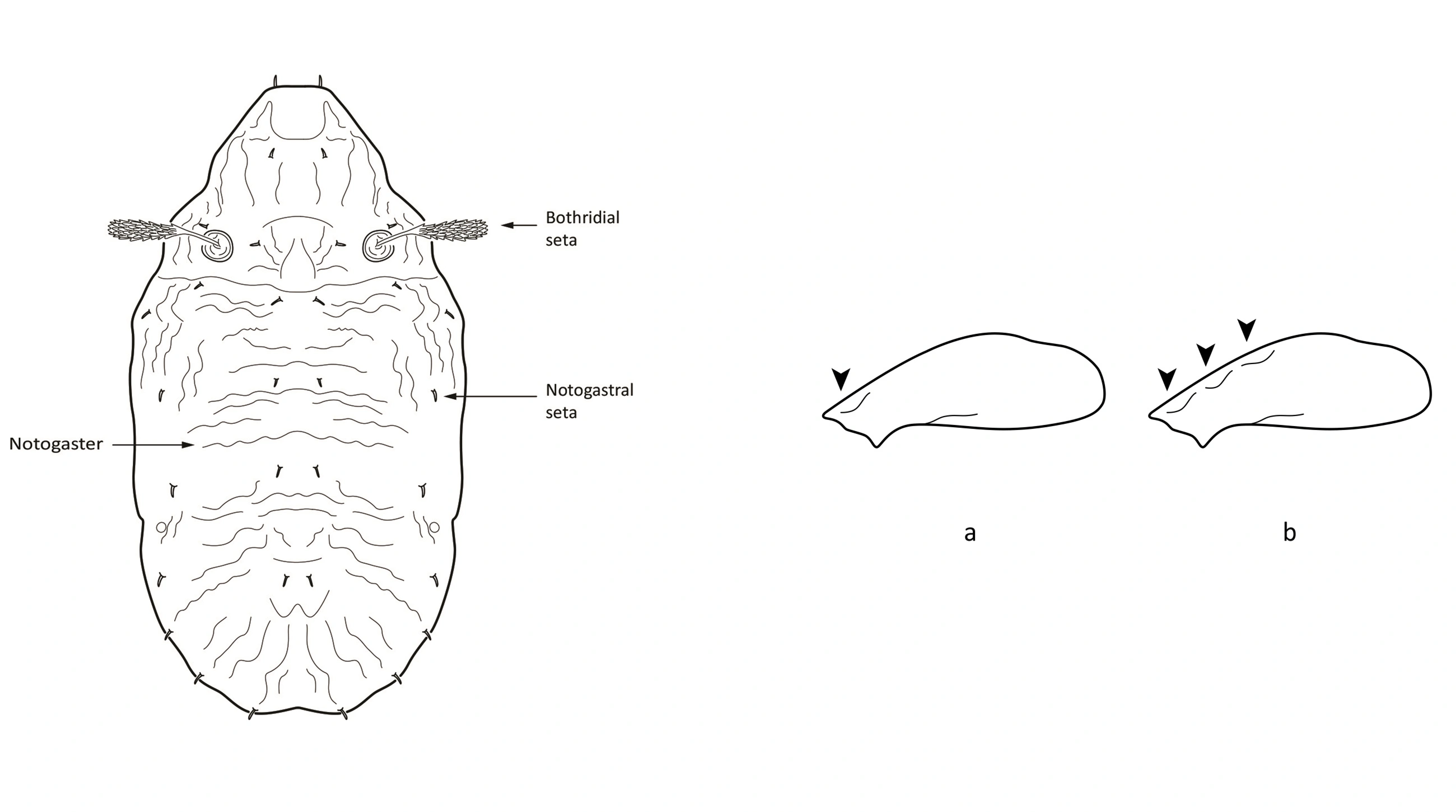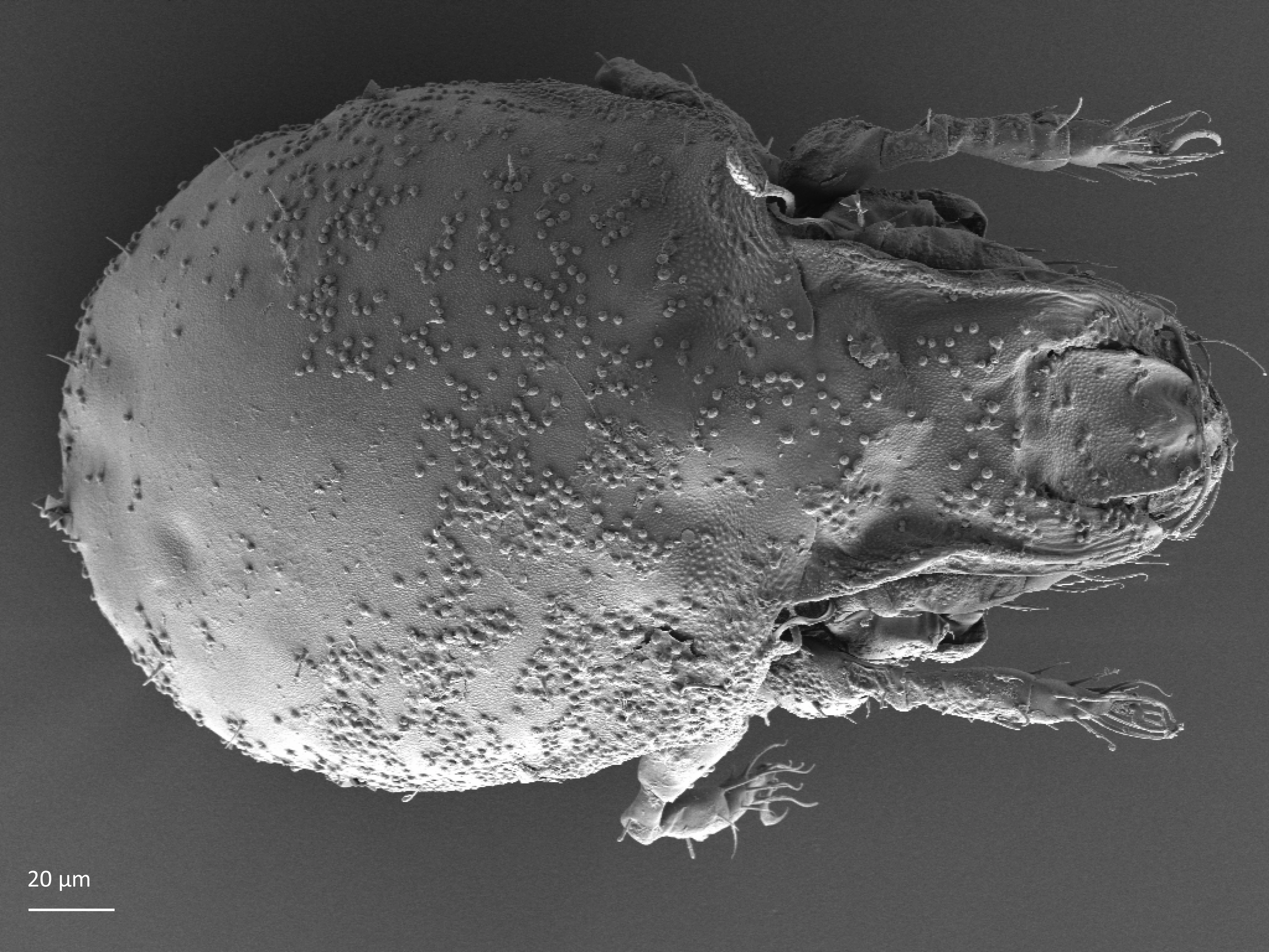Tectocepheus velatus
Tectocepheus velatus is one of the most common oribatid species, both in Norway and world-wide. It is a pioneer species, colonizing new areas for example after receding glaciers. It is abundant in different nature types, and most often in soil. Tectocepheus velatus has wide feeding preferences, and eats bacteria, fungi, dead organic matter and living green plants. It reproduces parthenogenetically, females are produced from unfertilized eggs.
Description

Fig. 1. Dorsal view of Tectocepheus velatus, adult.
Adult: The length of the body is 280–371 µm, and the width is 156–263 µm. The color can vary from yellowish brown to dark-brown. The cuticle has characteristic coarse-grained surface (Fig. 1). The prodorsum has a pair of lamellae, which are connected by a thin translamella (looking as a line). Each of the lamellae has a long cusp that is rounded in the front. Bothridial seta has a long stem (about as long as a head) and a club-shaped barbed head. Interlamellar seta is small. In the front of notogaster, between the pteromorphs, there is a distinct pair of dents. Notogaster has 10 pairs of small setae.
Juvenile stages: Larva: body length 164 µm, width 88 µm. Protonymph: body length 210 µm, width 109 µm. Deutonymph: body length 231 µm, width 113 µm. Tritonymph – body length 281 µm, width 147 µm. The color is whitish-light brown. The stem of bothridial setae is relatively shorter than in adults (Fig. 2), and the head of bothridial setae is clavate, bearing small seate. Notogaster has wrinkled cuticle and small setae.

Fig. 2 (left). Dorsal view of Tectocepheus velatus, juvenile.
Fig. 3 (right). Lateral view of the notogaster of Tectocepheus. Notogaster with one pair of dents in Tectocepheus velatus (a), and notogaster with three pairs of dents in Tectocepheus sarekensis (b).
Look-alikes

Fig. 4. Prodorsum and part of notogaster of Tectocepheus velatus.
Tectocepheus velatus is similar to T. sarekensis Trägårdh, 1910, but the species differ by the number of dents in the front of notogaster; T. velatus has one pair of such dents (marked by arrowhead in Fig. 3), while T. sarekensis has three pairs (marked by arrowheads in Fig. 3). T. velatus also lacks longitudinal stripes on the prodorsum in the region between the lamellae (Fig. 4), which are present in T. sarekensis (Fig. 5).
Biology
Reproduction is parthenogenetic, only females are present and they are produced from unfertilized eggs. Development time from egg to adult lasts 85 days in 16–20 °C. Tectocepheus velatus is opportunistic herbo-fungivore, which means that it is able to digest cellulose in litter and cell-walls of living green plants and trehalose in fungi.
Ecology
Distribution
Tectocepheus velatus is cosmopolitan, it is found world-wide.
Habitat
The species is extremely eurytopic. It occures in many different habitat types and is often numerous. It is found mainly in soils, and is more abundant in upper soil layers (0-3 cm). Tectocepheus velatus can also be found on trees and other plants, on stones, walls, and roofs of buildings.
Findings in Norway
Tectocepheus velatus is very common in Norway and has been found in nearly all our studies, for example in forests, bogs, also in arctic tundra in Svalbard. It is a pioneer species and was the first colonizer in the foreland of the receding glacier Hardangerjøkulen in central south Norway. Tectocepheus velatus was also the most abundant oribatid mite in the mosses growing on roofs of buildings in Sogn og Fjordane, with a density of about 400 individuals per 500 cm3 of moss.
References
Chistyakov MP (1972). Postembryonic development of Tectocepheus velatus (Oribatei). Zoologicheskii Zhurnal 51, 604–607.
Graczyk R and Seniczak S (2013). Oribatid mites (Acari: Oribatida) from roofs of houses in Sogn og Fjordane (Norway) Biological Letters, 50(2), 77–85. doi.org/10.2478/biolet-2013-0012
Hågvar S and Abrahamsen G (1980). Colonisation by Enchytraeidae, Collembola and Acari in sterile soil samples with adjusted pH levels. Oikos 34, 245–258.
Hågvar S and Kjøndal BR (1981). Effects of artificial acid rain on the microarthropod fauna in decomposing birch leaves. Pedobiologia 22, 409–422.
Hågvar S, Solhøy T and Mong CE (2009). Primary succession of soil mites (Acari) in a Norwegian glacier foreland, with emphasis on oribatid species. Arctic,. Antarctis and Alpine Research, 41, 219–227. doi.org/10.1657/1938-4246-41.2.219
Pfingstl T and Krisper G (2011). No difference in the juveniles of two Tectocepheus species (Acari: Oribatida, Tectocepheidae). Acarologia 51(2), 199–218. doi.org/10.1051/acarologia/20112005ff. ffhal-01600010f
Solhøy T (1979). Oribatids (Acari) from an oligotrophic mire in western Norway. Fauna Norvegica Ser B 26, 91–94.
Subías LS (2004). Listado sistemático, sinonímico y biogeográfico de los ácaros oribátidos (Acariformes, Oribatida) del mundo (excepto fósiles). Graellsia 60 (número extraordinario), 3–305.
Thunes KH, Skartveit J, Gjerde I, Starý J, Solhøy T, Fjellberg A, Kobro S, Nakahara S, zur Strassen R, Vierbergen G, Szadziewski R, Hagan DV, Grogan Jr WL, Jonassen T, Aakra K, Anonby J, Greve L, Aukema B, Heller K, Michelsen V.,Haenni J-P, Emeljanov AF, Douwes P, Berggren K, Franzen J, Disney RHL, Prescher S, Johanson KA, Mamaev B, Podenas S, Andersen S, Gaimari SD, Nartshuk E, Søli GEE, Papp L, Midtgaard F, Andersen A, von Tschirnhaus M, Bächli G, Olsen KM, Olsvik H, Földvári M, Raastad JE, Hansen LO and Djursvoll P (2004). The arthropod community of Scots pine (Pinus sylvestris L.) canopies in Norway. Entomologica Fennica 15, 65–90.
Weigmann G (2006). Hornmilben (Oribatida). Die Tierwelt Deutschlands. 520 pp. Vol. 76, Goecke and Evers, Keltern.
Siden siteres som:
Seniczak A (2020). Tectocepheus velatus (Michael, 1880). www.artsdatabanken.no/Pages/286332. Nedlastet <dag/måned/år>
